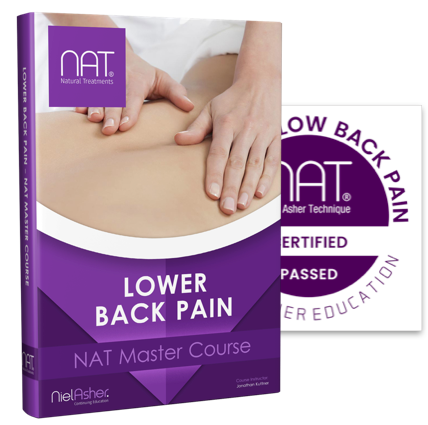Trigger Point therapy - Lower Back and the Sacroiliac Joint
Treating the Sacroiliac Joint
Treating Lower Back Pain - Online Course
Sacroiliac joint pain is implicated in 15% to 20% of chronic low back complaints
In the first part of the 20th century, sacroiliac (SI) joint syndrome was the most common diagnosis for lumbago (low back pain).
Pain in the lower back or buttocks, was generally referred to as Sacroiliac Syndrome or SI joint syndrome.
For about half a century (1930's - 1980's) most doctors ignored the sacroiliac in the diagnosis and treatment of low back pain, based on the mistaken view that a joint with so little movement could not be the cause of any serious pain syndrome.
Whilst that's generally now known not to be the case, the sacroiliac is still an area that is often overlooked.

Transmitting information back to the nervous system
While it has long been known that ligaments and joint capsules are densely innervated by sensory neurons (proprioceptors), it is now recognized that much of our posture control is modulated by means of ligaments.
Muscles contract and pull on their fascial attachments to ligaments in order to provide joint stability.
Although they were once thought of as merely passive restraints to joint motion, recent evidence suggests that many biological tissues, including the ligaments and surrounding fibrous connective tissue, have less organized but similar properties.
These contain contractile elements that enable them to respond in a mechanically stiffening or stabilizing manner (Schleip et al. 2012).
In other words, all the tissues surrounding a joint are as important for transmitting information back to the nervous system as they are for providing joint stability.
Stability and Lower Back Pain
The bones’ various shapes and the types of joints they form also determine how inherently stable a region of the body will be. Based on each bone’s unique architecture, the propensity towards stability of certain joint articulations is greater, while others are better designed for mobility.
The sacroiliac joints (SIJs) of the pelvis, are considered to have a greater level of inherent stability, or form closure—a term coined by Andry Vleeming and Chris Snijders (Lee 2011).
The rather unique design of the SIJs (see the illustration above) provides the stability needed for the transference of force from the extremities up through the trunk and spine, and from the trunk and spine down into the extremities.
Treating Ligamentous Trigger Points
This video shows a fabulous trigger point therapy technique that we use daily in our clinics for treating low back pain and have been using for years.
Super easy, super powerful, and super effective.
But ..... as always it's all about developing and honing that sense of touch. You've got to be able to feel the points, and that generally only comes with practice.
Do not attempt to perform these trigger point therapy techniques unless they fall within your scope of practice.
Find a Trigger Point Professional in your area
Articles About Headaches and Trigger Points
Dry Needling for Trigger Points
Certify as a Trigger Point Therapist
NAT Online Trigger Point Courses:
This trigger point therapy blog is intended to be used for information purposes only and is not intended to be used for medical diagnosis or treatment or to substitute for a medical diagnosis and/or treatment rendered or prescribed by a physician or competent healthcare professional. This information is designed as educational material, but should not be taken as a recommendation for treatment of any particular person or patient. Always consult your physician if you think you need treatment or if you feel unwell.
About Niel Asher Education
Niel Asher Education (NAT Global Campus) is a globally recognised provider of high-quality professional learning for hands-on health and movement practitioners. Through an extensive catalogue of expert-led online courses, NAT delivers continuing education for massage therapists, supporting both newly qualified and highly experienced professionals with practical, clinically relevant training designed for real-world practice.
Beyond massage therapy, Niel Asher Education offers comprehensive continuing education for physical therapists, continuing education for athletic trainers, continuing education for chiropractors, and continuing education for rehabilitation professionals working across a wide range of clinical, sports, and wellness environments. Courses span manual therapy, movement, rehabilitation, pain management, integrative therapies, and practitioner self-care, with content presented by respected educators and clinicians from around the world.
Known for its high production values and practitioner-focused approach, Niel Asher Education emphasises clarity, practical application, and professional integrity. Its online learning model allows practitioners to study at their own pace while earning recognised certificates and maintaining ongoing professional development requirements, making continuing education accessible regardless of location or schedule.
Through partnerships with leading educational platforms and organisations worldwide, Niel Asher Education continues to expand access to trusted, high-quality continuing education for massage therapists, continuing education for physical therapists, continuing education for athletic trainers, continuing education for chiropractors, and continuing education for rehabilitation professionals, supporting lifelong learning and professional excellence across the global therapy community.

Continuing Professional Education
Looking for Massage Therapy CEUs, PT and ATC continuing education, chiropractic CE, or advanced manual therapy training? Explore our evidence-based online courses designed for hands-on professionals.





















